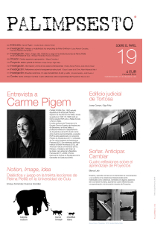Information and form in the contemporary city
DOI:
https://doi.org/10.5821/palimpsesto.19.8259Keywords:
Urban planning, information, big data, chaotic order, architecture.Abstract
The structure of the city owes much to the way in which its information is produced. The most basic one - which is to understand the cities hierarchies, flows, way of functioning, as well as our location within it - has historically required a physical support capable of conveying this information (e.g. its traces, geometries, axes). Moreover, if the need for information historically determined the urban shape and thus its understanding, what happens when both factors become disconnected, as it is occurs nowadays? What happens when information about the city does not require a physical support any longer?
The reality that is starting to become noticeable, is that the city (and its uses and flows) is starting to be reorganised under new paradigms that do not depend directly on the urban shape. Individual decision-making, multiplied and aggregated by new information systems, allow for diversity in the positioning and location of uses. These changes are predicting and advancing a city that is even more dispersed and multi-layered in its order
Downloads
Published
Issue
Section
License
PROTECTION AND INTELLECTUAL PROPERTY CRITERIA
Authors whose work is published in en Palimpsesto agree to the following terms:
1. The author retains the copyrights and guarantees the magazine the right to apply a Creative Commons Attribution-NonCommercial-NoDerivatives (CC BY-NC-ND), which permits others to share the work with acknowledgement of authorship.
2. The author may establish additional agreements of his or her own accord for non-exclusive distribution of the article published in the magazine (for example, in an institutional repository, or published in a book).
3. Electronic distribution of the work by the author(s) is permitted and encouraged (for example, in institutional repositories or on the author’s own website), prior to, and during the submission process, as this can generate productive exchanges, as well as earlier and greater citation of the published works (see The Effect of Open Access) (in English).
4. The author or provider of the material submitted for publication authorizes Palimpsesto to publish, with no obligation whatsoever (financial or otherwise) to the content of said material, be it in paper or digital format, or in any other medium.
5. The author or provider guarantees that he or she is the owner of the Intellectual Property rights to the contents provided, which encompasses the text and images/photographs/photographic works incorporated in the article.
6. The author or provider, exempts Palimpsesto magazine of all and any responsibility relating to violation of copyrights, thereby committing himself or herself to undertaking all efforts to assist Palimpsesto magazine in defence of any accusation, extra-judiciary, and/or judicial measures. Likewise, the author or provider will assume payment to Palimpsesto of any sum or compensation that must be paid to third parties for failure to comply with these obligations, be it the result of judicial, arbitrary or administrative decisions.
7. The submission of the texts by authors implies automatically a declaration of non plagiarism of its contents







